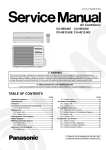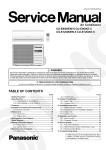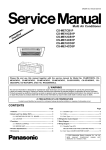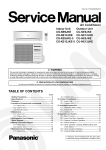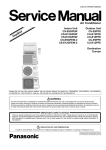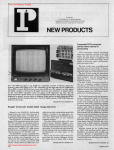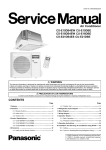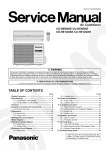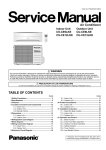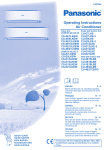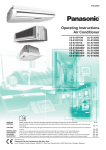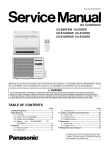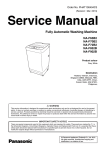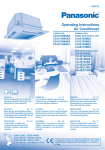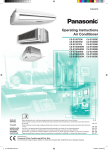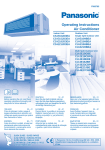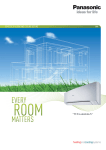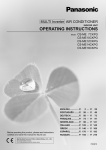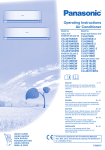Download Panasonic Air Conditioner
Transcript
Order No. PHAAM1003091C2 Air Conditioner Indoor Unit Outdoor Unit CS-E10KB4EA CU-E10HBEA Please file and use this manual together with the service manual for Model No. CU-2E15LBE CU-2E18LBE CU-3E18LBE CU-4E23LBE, Order No. PHAAM1003090C3 and CS-ME10CKPG CS-ME12CKPG CS-ME14CKPG CS-ME18CKPG CS-ME7CKPG CU-2E15CBPG CU-2E18CBPG CU-3E23CBPG CU-4E27CBPG Order No. RAC0209005C2 TABLE OF CONTENTS PAGE 1 Safety Precautions----------------------------------------------- 3 2 Specifications ----------------------------------------------------- 5 2.1. CS-E10KB4EA CU-E10HBEA------------------------- 5 2.2. CU-2E15LBE ----------------------------------------------- 8 2.3. CU-2E18LBE ----------------------------------------------- 9 2.4. CU-3E18LBE ----------------------------------------------10 2.5. CU-4E23LBE ---------------------------------------------- 11 2.6. CU-4E27CBPG -------------------------------------------12 3 Features ------------------------------------------------------------20 4 Location of Controls and Components ------------------21 5 6 7 8 PAGE 4.1. Indoor Unit ------------------------------------------------- 21 4.2. Outdoor Unit----------------------------------------------- 21 4.3. Remote Control------------------------------------------- 21 Dimensions ------------------------------------------------------- 22 5.1. Indoor Unit & Remote Control ------------------------ 22 5.2. Outdoor Unit----------------------------------------------- 23 Refrigeration Cycle Diagram -------------------------------- 24 Block Diagram --------------------------------------------------- 25 Wiring Connection Diagram--------------------------------- 26 8.1. Indoor Unit ------------------------------------------------- 26 © Panasonic HA Air-Conditioning (M) Sdn. Bhd. 2010. Unauthorized copying and distribution is a violation of law. 8.2. Outdoor Unit ----------------------------------------------- 27 9 Electronic Circuit Diagram----------------------------------- 28 9.1. Indoor Unit ------------------------------------------------- 28 9.2. Outdoor Unit ----------------------------------------------- 29 10 Printed Circuit Board ------------------------------------------ 30 10.1. Indoor Unit ------------------------------------------------- 30 10.2. Outdoor Unit ----------------------------------------------- 31 11 Installation Instruction ---------------------------------------- 33 11.1. Select The Best Location ------------------------------ 33 11.2. Indoor/Outdoor Unit Installation Diagram ---------- 33 11.3. Indoor Unit ------------------------------------------------- 33 11.4. Outdoor Unit ----------------------------------------------- 40 12 Operation and Control----------------------------------------- 44 12.1. Basic Function -------------------------------------------- 44 12.2. Airflow Direction ------------------------------------------ 46 12.3. Quiet operation (Cooling Mode/Cooling area of Soft Dry Mode) ---------------------------------------- 47 12.4. Powerful Mode Operation ------------------------------ 48 12.5. Timer Control---------------------------------------------- 49 12.6. Auto Restart Control------------------------------------- 49 12.7. Indication Panel------------------------------------------- 49 12.8. Drain Pump Control Operation ----------------------- 50 13 Protection Control ---------------------------------------------- 51 13.1. Protection Control For All Operations--------------- 51 13.2. Protection Control For Cooling & Soft Dry Operation--------------------------------------------------- 52 13.3. Protection Control For Heating Operation --------- 54 14 Servicing Mode -------------------------------------------------- 55 14.1. Auto OFF/ON Button ------------------------------------ 55 14.2. Select Remote Control Transmission Code ------- 56 15 Troubleshooting Guide---------------------------------------- 57 15.1. Refrigeration Cycle System --------------------------- 57 15.2. Relationship Between The Condition Of The Air Conditioner And Pressure And Electric Current ------------------------------------------------------ 58 15.3. Breakdown Self Diagnosis Function ---------------- 59 15.4. Error Codes Table---------------------------------------- 60 15.5. Self-diagnosis Method ---------------------------------- 61 16 Disassembly and Assembly Instructions --------------- 84 16.1. Disassembly of Parts------------------------------------ 84 17 Technical Data---------------------------------------------------- 87 17.1. Operation Characteristics ------------------------------ 87 17.2. Sensible Capacity Chart-------------------------------- 91 18 Exploded View and Replacement Parts List ----------- 92 18.1. Indoor Unit ------------------------------------------------- 92 18.2. CZ-BT20E (Front Grille Complete) ------------------ 95 18.3. Outdoor Unit ----------------------------------------------- 97 2 1 Safety Precautions • Read the following “SAFETY PRECAUTIONS” carefully before perform any servicing. • Electrical work must be installed or serviced by a licensed electrician. Be sure to use the correct rating of the power plug and main circuit for the model installed. • The caution items stated here must be followed because these important contents are related to safety. The meaning of each indication used is as below. Incorrect installation or servicing due to ignoring of the instruction will cause harm or damage, and the seriousness is classified by the following indications. This indication shows the possibility of causing death or serious injury. This indication shows the possibility of causing injury or damage to properties. • The items to be followed are classified by the symbols: This symbol denotes item that is PROHIBITED from doing. • Carry out test run to confirm that no abnormality occurs after the servicing. Then, explain to user the operation, care and maintenance as stated in instructions. Please remind the customer to keep the operating instructions for future reference. 1. Do not modify the machine, part, material during repairing service. 2. If wiring unit is supplied as repairing part, do not repair or connect the wire even only partial wire break. Exchange the whole wiring unit. 3. Do not wrench the fasten terminal. Pull it out or insert it straightly. 4. Engage dealer or specialist for installation and servicing. If installation of servicing done by the user is defective, it will cause water leakage, electrical shock or fire. 5. Install according to this installation instructions strictly. If installation is defective, it will cause water leakage, electric shock or fire. 6. Use the attached accessories parts and specified parts for installation and servicing. Otherwise, it will cause the set to fall, water leakage, fire or electrical shock. 7. Install at a strong and firm location which is able to withstand the set’s weight. If the strength is not enough or installation is not properly done, the set will drop and cause injury. 8. For electrical work, follow the local national wiring standard, regulation and the installation instruction. An independent circuit and single outlet must be used. If electrical circuit capacity is not enough or defect found in electrical work, it will cause electrical shock or fire. 9. This equipment is strongly recommended to install with Earth Leakage Circuit Breaker (ELCB) or Residual Current Device (RCD). Otherwise, it may cause electrical shock and fire in case equipment breakdown or insulation breakdown. 10. Do not use joint cable for indoor / outdoor connection cable. Use the specified Indoor/Outdoor connection cable, refer to installation instruction CONNECT THE CABLE TO THE INDOOR UNIT and connect tightly for indoor / outdoor connection. Clamp the cable so that no external force will be acted on the terminal. If connecting or fixing is not perfect, it will cause heat up or fire at the connection. 11. Wire routing must be properly arranged so that control board cover is fixed properly. If control board cover is not fixed perfectly, it will cause heat-up or fire at the connection point of terminal, fire or electrical shock. 12. When install or relocate air conditioner, do not let any substance other than the specified refrigerant, eg. air etc. mix into refrigeration cycle (piping). (Mixing of air etc. will cause abnormal high pressure in refrigeration cycle and result in explosion, injury etc.) 13. Do not install outdoor unit near handrail of veranda. When installing air-conditioner unit at veranda of high rise building, child may climb up to outdoor unit and cross over the handrail and causing accident. 14. This equipment must be properly earthed. Earth line must not be connected to gas pipe, water pipe, earth of lightning rod and telephone. Otherwise, it may cause electric shock in case equipment breakdown or insulation breakdown. 15. Keep away from small children, the thin film may cling to nose and mouth and prevent breathing. 16. Do not use unspecified cord, modified cord, joint cord or extension cord for power supply cord. Do not share the single outlet with other electrical appliances. Poor contact, poor insulation or over current will cause electrical shock or fire. 17. Tighten the flare nut with torque wrench according to specified method. If the flare nut is over-tightened, after a long period, the flare may break and cause refrigerant gas leakage. 3 18. For R410A models, when connecting the piping, do not use any existing (R22) pipes and flares nuts. Using such same may cause abnormally high pressure in the refrigeration cycle (piping), and possibly result in explosion and injury. In case of using existing (R22) pipes during installation of R410A models, must carry out pump down properly to collect back the refrigerant and oil before installation new unit. Thickness of copper pipes used with R410A must be more than 0.6mm. Never use copper pipes thinner than 0.6mm. It is desirable that the amount of residual oil is less than 40 mg/10m. 19. During installation, install the refrigerant piping properly before run the compressor. (Operation of compressor without fixing refrigeration piping and valves at opened condition will cause suck-in of air, abnormal high pressure in refrigeration cycle and result in explosion, injury etc.). 20. During pump down operation, stop the compressor before remove the refrigeration piping. (Removal of compressor while compressor is operating and valves are opened will cause suck-in of air, abnormal high pressure in refrigeration cycle and result in explosion, injury etc.) 21. After completion of the installation servicing, confirm there is no leakage of refrigerant gas. It may generate toxic gas when the refrigerant contacts with fire. 22. Ventilate if there is refrigerant gas leakage during operation. It may cause toxic gas when the refrigerant contacts with fire. 23. Do not insert your fingers or other objects into the unit, high speed rotating fan may cause injury. 24. Must not use other parts except original parts describe in catalog and manual. 1. Do not install the unit at place where leakage of flammable gas may occur. In case gas leaks and accumulates at surrounding of the unit, it may cause fire. 2. Carry out drainage piping as mentioned in installation instructions. If drainage is not perfect, water may enter the room and damage the furniture. 3. Tighten the flare nut with torque wrench according to specified method. If the flare nut is over-tightened, after a long period, the flare may break and cause refrigerant gas leakage. 4. Do not touch outdoor unit air inlet and aluminium fin. It may cause injury. 5. Select an installation location which is easy for maintenance. 6. Pb free solder has a higher melting point than standard solder; typically the melting point is 50°F - 70°F (30°C - 40°C) higher. Please use a high temperature solder iron. In case of the soldering iron with temperature control, please set it to 700 ± 20°F (370 ± 10°C). Pb free solder will tend to splash when heated too high (about 1100°F / 600°C). 7. Power supply connection to the conditioner. Connect the power supply cord of the air conditioner to the mains using one of the following methods. Power supply point shall be the place where there is ease for access for the power disconnection in case of emergency. In some countries, permanent connection of this room air conditioner to the power supply is prohibited. 1. Power supply connection to the receptacle using a power plug. Use an approved 15/16A (3/4~1.5HP) or 16A (2.0HP) or 20A (2.5HP) or 25A (3.0HP) power plug with earth pin for the connection to the socket. 2. Power supply connection to a circuit breaker for the permanent component. Use an approved 16A (3/4~2.0HP) or 20A (2.5HP) or 25A (3.0HP) circuit breaker for the permanent connection. It must be a double pole switch with a minimum 3.0 mm contact gap. 8. Do not release refrigerant during piping work for installation, servicing, reinstallation and during repairing a refrigeration parts. Take care of the liquid refrigerant, it may cause frostbite. 9. Installation or servicing work: It may need two people to carry out the installation or servicing work. 10. Do not install this appliance in a laundry room or other location where water may drip from the ceiling, etc. 11. Do not sit or step on the unit, you may fall down accidentally. 12. Do not touch the sharp aluminium fin, sharp parts may cause injury. 4 2 Specifications 2.1. CS-E10KB4EA CU-E10HBEA MODEL INDOOR CS-E10KB4EA OUTDOOR CU-E10HBEA Performance Test Condition EUROVENT / AS Phase, Hz Power Supply V Capacity C o o l i n g 230 Mid. Max. Min. Mid. kW 0.60 2.50 3.20 0.60 2.50 3.20 BTU/h 2050 8530 10900 2050 8530 10900 2750 520 2150 2750 520 2150 A — 2.9 — — 2.8 — Input Power W 145 620 870 145 620 870 kWh — 310 — — — — Annual Consumption EER Power Factor W/W 4.14 4.03 3.68 4.14 4.03 3.68 Btu/hW 14.1 13.8 12.5 14.1 13.8 12.5 % — 93 — — 92 — dB-A 34 / 26 / 23 Power Level dB 47 / - / - dB-A 45 / - / - Power Level dB 58 / - / - kW 0.60 3.20 5.10 0.60 3.20 5.10 BTU/h 2050 10900 17400 2050 10900 17400 Kcal/h 520 2750 4390 520 2750 4390 Running Current A — 3.8 — — 3.7 — Input Power W 125 820 1.45k 125 820 1.45k Capacity COP Power Factor W/W 4.80 3.90 3.52 4.80 3.90 3.52 Btu/hW 16.4 13.3 12.0 16.4 13.3 12.0 % — 94 — — 92 — dB-A Indoor Noise (H / L / QLo) Outdoor Noise (H / L) 35 / 28 / 25 Power Level dB 48 / - / - dB-A 46 / - / - Power Level dB 59 / - / - Max Current (A) / Max Input Power (W) 6.7 / 1.45k Starting Current (A) 3.8 Type Compressor Hermetic Motor Motor Type Brushless (4-poles) Output Power W 750 Type Backward Fan Material ABS+GF10% Motor Type F A N Max. Kcal/h Outdoor Noise (H / L) I N D O O R 240 Min. Running Current Indoor Noise (H / L / QLo) H e a t i n g Single, 50 DC Motor (8 poles) Input Power W Output Power QLo Lo Speed Me Hi SHi — W 40 Cool rpm 350 - 350 Heat rpm 410 - 410 Cool rpm 400 - 400 Heat rpm 440 - 440 Cool rpm 480 - 480 Heat rpm 510 - 510 Cool rpm 560 - 560 Heat rpm 580 - 580 Cool rpm 600 - 600 Heat rpm 630 - 630 5 MODEL O U T D O O R F A N INDOOR CS-E10KB4EA OUTDOOR CU-E10HBEA Type Propeller Fan Material PP Motor Type PWM (8-poles) Cool Input Power Output Power Speed Hi 40 Cool rpm 750 Heat rpm 720 L/h (Pt/h) 1.5 (3.2) Cool Lo Me Indoor Airflow Hi SHi Outdoor Airflow 3 3 7.1 (250) 3 3 m /min (ft /min) Heat m /min (ft /min) 8.0 (280) Cool m3/min (ft3/min) 7.9 (280) Heat m3/min (ft3/min) 8.5 (300) Cool m3/min (ft3/min) 9.2 (330) Heat 3 3 m /min (ft /min) 9.6 (340) Cool m3 3 10.5 (370) /min (ft /min) Heat m (ft3/min) 10.8 (380) Cool m3/min (ft3/min) 11.2 (400) Heat Hi — W Moisture Removal QLo — W Heat 3/min 3 3 11.6 (410) 3 3 m /min (ft /min) Cool m /min (ft /min) 28.8 (1020) Heat m3/min (ft3/min) 28.5 (1010) cm3 RB68A or Freol Alpha 68M (400) Control Device Refrigeration Cycle Refrigerant Oil Refrigerant Type Dimension Weight g (oz) R410A, 1.15k (40.6) Height (I/D / O/D / PANEL) mm (inch) 260 (10-14) / 540 (21-9/32) / 51 (2-1/32) Width (I/D / O/D / PANEL) mm (inch) 575 (22-21/32) / 780 (30-23/32) / 700 (27-9/16) Depth (I/D / O/D / PANEL) mm (inch) 575 (22-21/32) / 289 (11-13/32) / 700 (27-9/16) kg (lb) 18 (40) / 35 (77) / 2.5 (6) mm (inch) 6.35 (1/4) / 9.52 (3/8) Net (I/D / O/D / PANEL) Pipe Diameter (Liquid / Gas) P I P I N G Expansion Valve Standard Length m (ft) 7.5 (24.6) Length Range (min - max) m (ft) 3 (9.8) ~ 20 (65.6) I/D & O/D Height Different Additional Gas Amount Length for Additional Gas Drain Hose m (ft) 15.0 (49.2) g/m (oz/ft) 20 (0.2) m (ft) 10.0 (32.8) Inner Diameter mm 30 Length mm 193 Fin Material Indoor Heat Exchanger Aluminium (Pre Coat) Fin Type Slit Fin Row × Stage × FPI Size (W × H × L) 2 × 10 × 18 1330 × 210 × 25.4 1270 mm Fin Material Outdoor Heat Exchanger Aluminium Fin Type Corrugated Fin Row × Stage × FPI Size (W × H × L) Air Filter 2 × 24 × 17 18.19 × 504 × 713 mm Material — Type — Power Supply Power Supply Cord Outdoor A — Thermostat Electronic Control Protection Device Electronic Control 6 MODEL INDOOR CS-E10KB4EA OUTDOOR Cooling Indoor Operation Range Heating Cooling Outdoor Operation Range Heating CU-E10HBEA Dry Bulb Wet Bulb Maximum 32 23 11 Minimum 16 Maximum 30 — Minimum 16 — Maximum 43 26 Minimum -10 — Maximum 24 18 Minimum -10 — 1. Cooling capacities are based on indoor temperature of 27°C Dry Bulb (80.6°F Dry Bulb), 19.0°C Wet Bulb (66.2°F Wet Bulb) and outdoor air temperature of 35°C Dry Bulb (95°F Dry Bulb), 24°C Wet Bulb (75.2°F Wet Bulb) 2. Heating capacities are based on indoor temperature of 20°C Dry Bulb (68°F Dry Bulb) and outdoor air temperature of 7°C Dry Bulb (44.6°F Dry Bulb), 6°C Wet Bulb (42.8°F Wet Bulb) 3. Specifications are subject to change without notice for further improvement. 7 2.2. CU-2E15LBE Item Unit OUTDOOR UNIT Indoor Unit Combination 2.5kW + 2.5kW Power Source 1 Phase, 230V, 50Hz (Power supply from outdoor unit) Capacity Cooling Operation Running Current Electrical Power Input Data EER Noise Sound Pressure Level 15300 (5120 ~ 17700) A 5.75 kW 1.23 (0.25 ~ 1.52) W/W 3.66 (6.00 ~ 3.42) 47 / - dB (H/L) 62 / - Sound Power Level Running Current Electrical Power Input Data COP kW 5.4 (1.1 ~ 7.0) BTU/h 18400 (3750 ~ 23900) A 5.20 kW 1.17 (0.21 ~ 1.67) W/W 4.62 (5.24 ~ 4.19) dB-A (H/L) 49 / - dB (H/L) 64 / - Maximum Current A 12.0 Starting Current A 5.75 Circuit Breaker Capacity A 15 Height mm 540 Width mm 780 (+70) Depth mm 289 Noise Dimension Sound Pressure Level 4.5 (1.5 ~ 5.2) BTU/h dB-A (H/L) Capacity Heating Operation kW Sound Power Level Net Weight kg 38 3 + 1 (Earth) ø1.5 mm2 Connection Cable Pipe Length Range (1 room) m 3 ~ 20 Maximum Pipe Length (Total Room) m 30 Liquid Side mm (inch) 6.35 (1/4) Gas Side mm (inch) Refrigerant Pipe Diameter 9.52 (3/8) Type Compressor Hermetic Motor Motor Type Brushless (4-poles) Rated Output W 1.20k Type Air Circulation Propeller Fan Motor Type DC Motor (8-poles) Rated Output Fan Speed High (Cooling / Heating) W 40 RPM 860 / 860 Type Plate fin configuration forced draft type Tube Material Heat Exchanger Copper Fin Material Aluminum (Pre Coat) Row / Stage 2 / 20 FPI Air Volume 19 m3/min High (Cooling / Heating) 33.3 / 28.5 Refrigerant Control Device Expansion Valve Refrigerant Oil RB68A / Freol Alpha68M Refrigerant (R410A) g Cooling Indoor Operation Range Heating Cooling Outdoor Operation Range Heating 1.45k Dry Bulb Wet Bulb Maximum 32 23 Minimum 16 11 Maximum 30 — Minimum 16 — Maximum 43 26 Minimum 16 11 Maximum 24 18 Minimum -10 -11 Note • Specifications are subject to change without notice for further improvement. 8 2.3. CU-2E18LBE Item Unit OUTDOOR UNIT Indoor Unit Combination 3.2kW + 3.2kW Power Source 1 Phase, 230V, 50Hz (Power supply from outdoor unit) Capacity Cooling Operation Running Current Electrical Power Input Data EER Noise Sound Pressure Level 5.2 (1.5 ~ 5.4) BTU/h 17700 (5120 ~ 18400) A 7.10 kW 1.52 (0.25 ~ 1.58) W/W 3.42 (6.00 ~ 3.42) dB-A (H/L) 49 / - Sound Power Level Capacity Heating Operation kW Running Current Electrical Power Input Data COP dB (H/L) 64 / - kW 5.6 (1.1 ~ 7.2) BTU/h 19100 (3750 ~ 24600) A 5.35 kW 1.21 (0.21 ~ 1.70) W/W 4.63 (5.24 ~ 4.24) dB-A (H/L) 51 / - dB (H/L) 66 / - Maximum Current A 12.0 Starting Current A 7.1 Circuit Breaker Capacity A 15 Height mm 540 Width mm 780 (+70) Depth mm 289 Noise Dimension Sound Pressure Level Sound Power Level Net Weight kg 38 3 + 1 (Earth) ø1.5 mm2 Connection Cable Pipe Length Range (1 room) m 3 ~ 20 Maximum Pipe Length (Total Room) m 30 Liquid Side mm (inch) 6.35 (1/4) Gas Side mm (inch) Refrigerant Pipe Diameter 9.52 (3/8) Type Compressor Hermetic Motor Motor Type Brushless (4-poles) Rated Output W 1.50k Type Air Circulation Propeller Fan Motor Type DC Motor (8-poles) Rated Output Fan Speed High (Cooling / Heating) W 40 RPM 890 / 890 Type Plate fin configuration forced draft type Tube Material Heat Exchanger Copper Fin Material Aluminum (Pre Coat) Row / Stage 2 / 20 FPI Air Volume 19 m3/min High (Cooling / Heating) 34.5 / 31.0 Refrigerant Control Device Expansion Valve Refrigerant Oil RB68A / Freol Alpha68M Refrigerant (R410A) g Cooling Indoor Operation Range Heating Cooling Outdoor Operation Range Heating 1.45k Dry Bulb Wet Bulb Maximum 32 23 Minimum 16 11 Maximum 30 — Minimum 16 — Maximum 43 26 Minimum 16 11 Maximum 24 18 Minimum -10 -11 Note • Specifications are subject to change without notice for further improvement. 9 2.4. CU-3E18LBE Item Unit OUTDOOR UNIT Indoor Unit Combination 2.0kW + 2.0kW + 5.0kW Power Source 1 Phase, 230V, 50Hz (Power supply from outdoor unit) Capacity Cooling Operation Running Current Electrical Power Input Data EER Noise Sound Pressure Level Sound Power Level 17700 (6140 ~ 24900) A 5.3 kW 1.20 (0.36 ~ 2.18) W/W 4.33 (5.00 ~ 3.35) 46 / - dB (H/L) 60 / - Running Current Electrical Power Input Data COP kW 6.8 (1.6 ~ 8.3) BTU/h 23200 (5460 ~ 28300) A 6.5 kW 1.40 (0.32 ~ 2.11) W/W 4.86 (5.00 ~ 3.93) dB-A (H/L) 47 / - dB (H/L) 61 / - Maximum Current A 15.2 Starting Current A 6.5 Circuit Breaker Capacity A 16 Height mm 795 Width mm 875 (+95) Depth mm 320 Noise Dimension Sound Pressure Level 5.2 (1.8 ~ 7.3) BTU/h dB-A (H/L) Capacity Heating Operation kW Sound Power Level Net Weight kg 71 3 + 1 (Earth) ø1.5 mm2 Connection Cable Pipe Length Range (1 room) m 3 ~ 25 Maximum Pipe Length (Total Room) m 50 Liquid Side mm (inch) 6.35 (1/4) Gas Side mm (inch) Refrigerant Pipe Diameter 9.52 (3/8) Type Compressor Hermetic Motor Motor Type Brushless (4-poles) Rated Output W 1.30k Type Air Circulation Propeller Fan Motor Type DC Motor (8-poles) Rated Output Fan Speed High (Cooling / Heating) W 60 RPM 580 / 580 Type Plate fin configuration forced draft type Tube Material Heat Exchanger Copper Fin Material Aluminum (Pre Coat) Row / Stage 2 / 36 FPI Air Volume 19 m3/min High 41.7 Refrigerant Control Device Expansion Valve Refrigerant Oil FV50S Refrigerant (R410A) g Cooling Indoor Operation Range Heating Cooling Outdoor Operation Range Heating 2.64k Dry Bulb Wet Bulb Maximum 32 23 Minimum 16 11 Maximum 30 — Minimum 16 — Maximum 46 26 Minimum -10 — Maximum 24 18 Minimum -15 -16 Note • Specifications are subject to change without notice for further improvement. 10 2.5. CU-4E23LBE Item Unit Indoor Unit Combination Power Source 1 Phase, 230V, 50Hz (Power supply from outdoor unit) Capacity Cooling Operation Running Current Electrical Power Input Data EER Noise Sound Pressure Level Sound Power Level kW 6.8 (1.9 ~ 8.8) BTU/h 23200 (6480 ~ 30000) A 7.5 kW 1.68 (0.34 ~ 2.47) W/W 4.05 (5.59 ~ 3.56) dB-A (H/L) 48 / - dB (H/L) 62 / - kW 8.6 (3.0 ~ 10.6) BTU/h 29300 (10200 ~ 36100) Capacity Heating Operation OUTDOOR UNIT 2.0kW + 2.0kW + 2.0kW + 5.0kW Running Current Electrical Power Input Data COP A 8.6 kW 1.85 (0.58 ~ 2.60) W/W 4.65 (5.17 ~ 4.08) dB-A (H/L) 49 / - dB (H/L) 63 / - Maximum Current A 15.6 Starting Current A 8.6 Circuit Breaker Capacity A 20 Height mm 795 Width mm 875 (+95) Depth mm 320 Noise Dimension Sound Pressure Level Sound Power Level Net Weight kg 72 3 + 1 (Earth) ø1.5 mm2 Connection Cable Pipe Length Range (1 room) m 3 ~ 25 Maximum Pipe Length (Total Room) m 60 Liquid Side mm (inch) 6.35 (1/4) Gas Side mm (inch) Refrigerant Pipe Diameter 9.52 (3/8) Type Compressor Hermetic Motor Motor Type Brushless (4-poles) Rated Output W 1.30k Type Air Circulation Propeller Fan Motor Type DC Motor (8-poles) Rated Output Fan Speed High (Cooling / Heating) W 60 RPM 600 / 620 Type Plate fin configuration forced draft type Tube Material Heat Exchanger Copper Fin Material Aluminum (Pre Coat) Row /S tage 2 / 36 FPI Air Volume 19 m3/min High (Cooling / Heating) 42.5 / 44.1 Refrigerant Control Device Expansion Valve Refrigerant Oil FV50S Refrigerant (R410A) g Cooling Indoor Operation Range Heating Cooling Outdoor Operation Range Heating 2.46k Dry Bulb Wet Bulb Maximum 32 23 Minimum 16 11 Maximum 30 — Minimum 16 — Maximum 46 26 Minimum -10 — Maximum 24 18 Minimum -15 -16 Note • Specifications are subject to change without notice for further improvement. 11 2.6. CU-4E27CBPG Item Unit OUTDOOR UNIT Indoor Unit Combination 3.2kW + 3.2kW + 3.2kW + 4.0kW Power Source Single Phase, 230V, 50Hz (Power supply from outdoor unit) Capacity kW Running Current Cooling Operation Electrical Power Input Data EER Noise 8.70 W 1980 (530 - 2870) W/W 4.04 Sound Pressure Level dB 48 Sound Power Level dB 61 kW 9.4 (4.2 - 10.6) Capacity Heating Operation 8.0 (3.0 - 9.2) A Running Current Electrical Power Input Data COP A 9.10 W 2080 (700 - 3060) W/W 4.52 Sound Pressure Level dB 49 Sound Power Level dB 62 A 19.0 Starting Current A 9.10 Circuit Breaker Capacity A 20 Height mm 908 Width mm 900 Depth mm 320 kg 73 Noise Maximum Current Dimension Net Weight 3 + 1 (Earth) ø1.5 mm2 Connection Cable Pipe Length Range (1 room) m Maximum Pipe Length (Total Room) m 70 Liquid Side mm 6.35 Gas Side mm 9.52 Refrigerant Pipe Diameter Type Compressor Hermetically Sealed Swing Type Motor Type DC Brushless (4-poles) Rated Output W Type Air Circulation Motor Type DC Brushless (8-poles) W 51 Low rpm 680 High rpm Type Copper Fin Material Aluminum Row / Stage 2 / 40 FPI Air Volume 780 Plate fin configuration forced draft type Tube Material Heat Exchanger 2200 Propeller Fan Rated Output Fan Speed 3 - 25 19 Low Cooling (Heating) m3/min High Cooling (Heating) m3/min Refrigerant Control Device 42 (42) 48.5 (45) Expansion Valve Refrigerant Oil FOC50K (Ethers) Refrigerant (R410A) g Note • Specifications are subject to change without notice for further improvement. 12 3,100 • Multi Split Combination Possibility: - A single outdoor unit enables air conditioning of up to two separate rooms for CU-2E15LBE, CU-2E18LBE. - A single outdoor unit enables air conditioning of up to three separate rooms for CU-3E18LBE. - A single outdoor unit enables air conditioning of up to four separate rooms for CU-4E23LBE, CU-4E27CBPG. 13 • Outdoor Unit : CU-2E15LBE • Outdoor Unit : CU-2E18LBE 14 • Outdoor Unit : CU-3E18LBE 15 • Outdoor Unit : CU-4E23LBE 16 17 • Outdoor Unit : CU-4E27CBPG 18 19 3 Features • Inverter Technology - Wider output power range - Energy saving - Quick Cooling - Quick Heating - More precise temperature control • Environment Protection - Non-ozone depletion substances refrigerant (R410A) • Long Installation Piping - Long piping up to 20 meter • Easy to use remote control • Quality Improvement - Random auto restart after power failure for safety restart operation - Gas leakage protection - Prevent compressor reverse cycle - Inner protector to protect compressor - Noise prevention during soft dry operation • Operation Improvement - Quiet mode to reduce the indoor unit operating sound - Powerful mode to reach the desired room temperature quickly - 24-hour timer setting • Serviceability Improvement - Breakdown Self Diagnosis function 20 4 Location of Controls and Components 4.1. Indoor Unit 4.2. Outdoor Unit 4.3. Remote Control 21 5 Dimensions 5.1. Indoor Unit & Remote Control 22 5.2. Outdoor Unit 23 6 Refrigeration Cycle Diagram Model Gas E10HBEA 3/8” Piping size Liquid 1/4” Rated Length (m) Max Elevation (m) 7.5 15 Min. Piping Length (m) 3 Max. Piping Length (m) 20 Additional Refrigerant (g/m) 20 * If piping length is over common length, additional refrigerant should be added as shown in the table. 24 7 Block Diagram 25 8 Wiring Connection Diagram 8.1. Indoor Unit 26 8.2. Outdoor Unit 27 9 Electronic Circuit Diagram 9.1. Indoor Unit 28 9.2. Outdoor Unit 29 10 Printed Circuit Board 10.1. Indoor Unit 10.1.1. Main Printed Circuit Board 30 10.2. Outdoor Unit 10.2.1. Main Printed Circuit Board 31 10.2.2. CPU Printed Circuit Board 32 11 Installation Instruction 11.1. Select The Best Location 11.2. Indoor/Outdoor Unit Installation OUTDOOR UNIT • If an awning is built over the unit to prevent direct sunlight or rain, be careful that heat radiation from the condenser is not obstructed. • There should not be any animal or plant which could be affected by hot air discharged. • Keep the spaces indicated by arrows from wall, ceiling, fence or other obstacles. • Do not place any obstacles which may cause a short circuit of the discharged air. • If piping length is over 10m, additional refrigerant should be added as shown in the table. Model Diagram Min. Max. Additional Max Piping size Rated Length Elevation Piping Piping Refrigerant (g/m) Length Length (m) (m) Gas Liquid (m) (m) E10HBEA 3/8” 1/4” 7.5 15 3 20 20 E15HBEA 1/2” 1/4” 7.5 15 3 20 20 E18HBEA, 1/2” E21HBEA 1/4” 5 20 3 30 20 Example: If the unit is installed at a 12m distance, the quantity of additional refrigerant should be 40g ...... (12 - 10) m x 20g/m = 40g • This illustration is for explanation purposes only. The indoor unit will actually face a different way. 11.3. Indoor Unit 11.3.1. SELECTING THE LOCATION FOR THE INDOOR UNIT Provide a check port on the piping side ceiling for repair and maintenance. • Install the indoor unit once the following conditions are satisfied and after receiving the customer approval. 1. The indoor unit must be within a maintenance space. 2. The indoor unit must be free from any obstacles in path of the air inlet and outlet, and must allow spreading of air throughout the room. 3. Recommended installation height for indoor unit shall be at least 2.5 m. * If the height from the floor to ceiling exceeds three meters, air flow distribution deteriorates and the effect is decreased. 33 The installation position must be able to support a load four times the indoor unit weight. The indoor unit must be away from heat and steam sources, but avoid installing it near an entrance. The indoor unit must allow easy draining. The indoor unit must allow easy connection to the outdoor unit. Place the indoor unit according to the height from the ceiling shown in the illustration below. The indoor unit must be from at least 3m away from any noise-generating equipment. The electrical wiring must be shielded with a steel conduit. 10. If the power supply is subject to noise generation, add a suppressor. 11. Do not install the indoor unit in a laundry. Electric shocks may result. 4. 5. 6. 7. 8. 9. NOTE • Thoroughly study the following installation locations 1. In such places as restaurants and kitchens, considerable amount of oil steam and flour adhere to the turbo fan, the fin of the heat exchanger and the drain pump, resulting in heat exchange reduction, spraying, dispersing of water drops, drain pump malfunction, etc. In these cases, take the following actions: • Make sure that the ventilation fan for smoke-collecting hood on a cooking table has sufficient capacity so that it draws oily steam which should not flow into the suction of the air conditioner. • Make enough distance from the cooking room to install the air conditioner in such place where it may not suck in oily steam. 2. Avoid installing the air conditioner in such circumstances where cutting oil mist or iron powder exist especially in factories, etc. 3. Avoid places where inflammable gas is generated, flows-in, contaminated, or leaked. 4. Avoid places where sulphurous acid gas or corrosive gas can be generated. 5. Avoid places near high frequency generators. Model Name CS-E10HB4** CS-E15HB4** CS-E18HB4** CS-E21HB4** 11.3.2. Height in the ceiling 280 mm or more INSTALLATION OF INDOOR UNIT • Be sure to discuss the ceiling drilling work with the workers concerned. This air conditioner uses a drain up motor. Horizontally install the unit using a level gauge. CEILING OPENING DIMENSIONS AND HANGING BOLT LOCATION The paper model for installation expand or shrink according to temperature and humidity. Check on dimensions before using it. CAUTION During the installation, care must be taken not to damage electric wires. • The dimensions of the paper model for installation are the same as those of the ceiling opening dimensions. 34 POSITIONS OF AIR CONDITIONER BODY AND CEILING SURFACE 11.3.3. REFRIGERANT PIPING Refrigerant is charged to the outdoor unit. For details, see the manual for installation work of outdoor unit. (Additional charging, etc.) 1. Brazing for piping. a. Execute brazing before tightening the flare nut. b. Brazing must be executed while blowing nitrogen gas. (This prevents generation of oxidized scale in copper pipe.) 2. When there is a lot of brazings for long piping, install a strainer midway of the piping. (The strainer is locally supplied.) 3. Use clean copper pipe with inner wall surface free from mist and dust. Blow nitrogen gas or air to blow off dust in the pipe before connection. 4. Form the piping according to its routing. Avoid bending and bending back the same piping point more than three times. (This will result in hardening of the pipe). 5. After deforming the pipe, align centers of the union fitting of the indoor unit and the piping, and tighten them firmly with wrenches. 6. Connect pipe to the service valve or ball valve which is located below the outdoor unit. 7. After completed the piping connection, be sure to check if there is gas leakage in indoor and outdoor connection. Vacuum drying After completing the piping connection, execute vacuum drying for the connecting piping and the indoor unit. The vacuum drying must be carried out by using the service ports of both the liquid and gas side valves. CAUTION Use two wrenches and tighten with regular torque. ø6.35 mm ø9.52 mm 18 (180) 42 (430) Flare nut fastening torque N·m (kgf·cm) ø12.7 mm 55 (560) ø19.05 mm ø15.88 mm 65 (660) Liquid size piping ø6.35 mm (1/4”) Gas side piping ø12.7 mm (1/2”) 35 100 (1020) 11.3.4. INDOOR UNIT DRAIN PIPING • During drain piping connection, be careful not to exert extra force on the drain port at the indoor unit. • The outside diameter of the drain connection at the indoor unit is 32mm. Piping material: Polyvinyl chloride pipe VP-25 and pipe fittings. • Be sure to perform heat insulation on the drain piping. Heat insulation material: Polyethylene foam with thickness more than 8 mm (local supply). • Drain piping must have down-slope (1/50 to 1/100); be sure not to provide up-and-down slope to prevent reversal flow. • Be sure to check no air trap on drain hose and to ensure smooth water flow and no abnormal sound. • The height of drain may be possible up to 750 mm. Drain Test • When drain set piping, install as shown in the figure below. The air conditioner uses a drain up motor to drain water. Use the following procedure to test the drain up motor operation. • • • • • Connect the main drain pipe to exterior and leave it provisionally until the test comes to an end. Feed water to the flexible drain hose and check the piping for leakage. Be sure to check the drain up motor for normal operating and noise when electric wiring is complete. When the test is complete, connect the flexible drain hose to the drain port. Pour about 600-700cc of water in the drain pan of the indoor unit. (Pour from the position specified in the drawing by using a water supply bottle or other suitable tool.) • Press the drain pump test run on pcb to start the drain motor, and verity water drainage. (The drain motor will automatically stop after operating for about five minutes.) 36 11.3.5. HEAT INSULATION Be sure to perform heat insulation on the drain, liquid and gas piping. Imperfection in heat insulation work leads to water leakage. 1. Use the heat insulation material for the refrigerant piping which has an excellent heat-resistance (over 120°C). 2. Precautions in high humidity circumstance. This air conditioner has been tested according to the “JIS Standard Conditions with Mist” and have been confirmed that there are no faults. However, if it is operated for a long time in high humid atmosphere (dew point temperature: more than 23°C), water drops are liable to fall. In this case, add heat insulation material according to the following procedure: • Heat insulation material to be prepared... Adiabatic glass wool with thickness 10 to 20 mm. • Stick glass wool on all air conditioners that are located in ceiling atmosphere. • In addition to the normal heat insulation (thickness: more than 8 mm) for refrigerant piping (gas piping: thick piping) and drain piping, add a further of 10 mm to 30 mm thickness material. Wall seal • When the outdoor unit is installed on a higher position than the indoor unit, install the trap so as not to instill rain water into the wall by transmitting in piping. • Stuff the space among piping, the electric wire, and the drain hose with “Putty” and seal the penetration wall hole. Make sure that rain water do not instill into the wall. 37 11.3.6. CONNECTING THE CABLE TO THE INDOOR • Remove the mounting screw, remove the control box cover, and then connect the wires by following the procedure given in the illustration. Earth lead wire shall be longer than other wires as shown in the figure for the electrical safety in case of the slipping out of the cord from anchorage. 11.3.6.1. WIRE STRIPPING AND CONNECTING REQUIREMENT 11.3.7. INSTALLATION OF DECORATIVE PANEL The decorative panel has its installation direction. Confirm the direction by displaying the piping side. 1. Remove the air inlet grille by moving the catchers to center. 2. Fitting the decorative panel • Temporarily secure the fixing screws (3 pcs.) before fitting the decorative panel. (For temporarily securing the front grille.) • Place decorative panel on the screws (3 pcs.) before fitting, move decorative panel as illustrated and tighten all the screws (4 pcs.). 38 CAUTION • Check before hand the height from the ceiling to the unit. • The front grille fitting direction is determined by the unit direction. • Only use the screws with the length of 35mm which is provided, to fix the decorative panel. • Do not use other screw which is longer it may cause damage to the drain-pan and other components. 3. Fit the decorative panel and ceiling wall together and confirm no gap in between. Readjust indoor unit height, if there is a gap between ceiling wall and decorative panel. 4. Open the indoor control box cover. (2 pcs) 5. Insert firmly the connector of cosmetic louver to indoor pcb CN-STM1, CN-STM2 and CN-DISP. Be caution not to clamp the cord in between control board and control board cover. 6. After complete, install back removed part follow opposite procedure. Be sure to hook the air inlet grill string, to prevent grill from falling and causing injury from it. 39 11.4. Outdoor Unit 11.4.1. SELECT THE BEST LOCATION (Refer to “Select the best location” section) 11.4.2. INSTALL THE OUTDOOR UNIT • After selecting the best location, start installation according to Indoor/Outdoor Unit Installation Diagram. 1. Fix the unit on concrete or rigid frame firmly and horizontally by bolt nut. (ø10 mm). 2. When installing at roof, please consider strong wind and earthquake. Please fasten the installation stand firmly with bolt or nails. Model E10HBEA E15HBEA, E18HBEA, E21HBEA 11.4.3. A 570 mm B 105 mm C 18.5 mm D 320 mm 612.5 mm 131 mm 19 mm 383 mm CONNECTING THE PIPING Connect The Piping To Indoor Unit Please make flare after inserting flare nut (locate at joint portion of tube assembly) onto the copper pipe. (In case of using long piping) Connect the piping • Align the center of piping and sufficiently tighten the flare nut with fingers. • Further tighten the flare nut with torque wrench in specified torque as stated in the table. Model E10HBEA E15HBEA, E18HBEA, E21HBEA Piping size (Torque) Gas Liquid 3/8” (42 N.m) 1/4” (18 N.m) 1/2” (55 N.m) 1/4” (18 N.m) CAUTION Do not over tighten, over tightening cause gas leakage. Connecting The Piping To Outdoor Unit Decide piping length and then cut by using pipe cutter. Remove burrs from cut edge. Make flare after inserting the flare nut (locate at valve) onto the copper pipe. Align center of piping to valves and then tighten with torque wrench to the specified torque as stated in the table. CUTTING AND FLARING THE PIPING 1. Please cut using pipe cutter and then remove the burrs. 2. Remove the burrs by using reamer. If burrs is not removed, gas leakage may be caused. Turn the piping end down to avoid the metal powder entering the pipe. 3. Please make flare after inserting the flare nut onto the copper pipes. 40 11.4.4. EVACUATION OF THE EQUIPMENT WHEN INSTALLING AN AIR CONDITIONER, BE SURE TO EVACUATE THE AIR INSIDE THE INDOOR UNIT AND PIPES in the following procedure. 1. Connect a charging hose with a push pin to the Low side of a charging set and the service port of the 3-way valve. • Be sure to connect the end of the charging hose with the push pin to the service port. 2. Connect the center hose of the charging set to a vacuum pump with check valve, or vacuum pump and vacuum pump adaptor. 3. Turn on the power switch of the vacuum pump and make sure that the needle in the gauge moves from 0 cmHg (0 MPa) to -76 cmHg (-0.1 MPa). Then evacuate the air approximately ten minutes. 4. Close the Low side valve of the charging set and turn off the vacuum pump. Make sure that the needle in the gauge does not move after approximately five minutes. Note: BE SURE TO FOLLOW THIS PROCEDURE IN ORDER TO AVOID REFRIGERANT GAS LEAKAGE. 5. Disconnect the charging hose from the vacuum pump and from the service port of the 3-way valve. 6. Tighten the service port caps of both of the 3-way valve at a torque of 18 N.m with a torque wrench. 7. Remove the valve caps of both of the 2-way valve and 3-way valve. Position both of the valves to “OPEN” using a hexagonal wrench (4 mm). 8. Mount valve caps onto the 2-way valve and the 3-way valve. • Be sure to check for gas leakage. CAUTION • • • • If gauge needle does not move from 0 cmHg (0 MPa) to -76 cmHg (-0.1 MPa), in step above take the following measure: If the leak stops when the piping connections are tightened further, continue working from step . If the leak does not stop when the connections are retightened, repair the location of leak. Do not release refrigerant during piping work for installation and reinstallation. Take care of the liquid refrigerant, it may cause frostbite. 41 11.4.5. CONNECT THE CABLE TO THE OUTDOOR UNIT (FOR DETAIL REFER TO WIRING DIAGRAM AT UNIT) 1. Remove the control board cover from the unit by loosening the screw. 2. Connecting cable between indoor unit and outdoor unit shall be approved polychloroprene sheathed 4 × 1.5 mm2 flexible cord, type designation 245 IEC 57 or heavier cord. 3. Secure the cable onto the control board with the holder (clamper). 4. Cable connection to the power supply through knife switch (Disconnecting means). • Connect the approved polychloroprene sheathed power supply cable (3 x 1.5 mm2), type designation 245 IEC 57 or heavier cord to the terminal board, and connect the other end of the cable to knife switch (Disconnecting means). 5. For wire stripping and connection requirement, refer to CONNECT THE CABLE TO THE INDOOR. Note: Knife switch (Disconnecting means) should have minimum 3.5 mm contact gap. • Secure the cable onto the control board with the holder (clamper). • Power supply earth cable must connect to the left earth terminal. 11.4.6. PIPE INSULATION 1. Please carry out insulation at pipe connection portion as mentioned in Indoor/Outdoor Unit Installation Diagram. Please wrap the insulated piping end to prevent water from going inside the piping. 2. If drain hose or connecting piping is in the room (where dew may form), please increase the insulation by using POLY-E FOAM with thickness 6 mm or above. DISPOSAL OF OUTDOOR UNIT DRAIN WATER • If a drain elbow is used, the unit should be placed on a stand which is taller than 3 cm. • If the unit is used in an area where temperature falls below 0°C for 2 or 3 days in succession, it is recommended not to use a drain elbow, for the drain water freezes and the fan will not rotate. AUTO SWITCH OPERATION The following operations can be performed by pressing the “AUTO” switch. 1. AUTO OPERATION MODE The Auto operation will be activated immediately once the Auto Switch is pressed. 2. TEST RUN OPERATION (FOR PUMP DOWN/ SERVICING PURPOSE) The Test Run operation will be activated if the Auto Switch is pressed continuously for more than 5 sec. to below 8 sec. A “pep” sound will occur at the fifth sec., in order to identify the starting of Test Run operation. 42 CHANGING THE REMOTE CONTROL TRANSMISSION CODE 1. Press AUTO SW continuously for 11 seconds (buzzer sound = pep pep pep) 2. After 11 seconds, release AUTO SW, then press RemoCon TIMER “ ” SW continuously for 5 seconds. Reset code will be transmitted. After the reset code is transmitted, release TIMER “ ” SW. 3. Press Remo-Con “OFF/ON” button. The new Remo-Con No. will be accepted and memorized, after which the new Remo-Con No. can be used. REMO-CON NO. CHANGE IN REMOTE CONTROL 1. Remove the batteries from the battery compartment of the Remote Control. 2. On the left side of the battery compartment, there is a small opening in the centre in which Jumper (J_A) can be seen. In the accepted Remo-Con PCB shown beside, Jumper (J_B) can be seen. J_A Short Open Short Open J_B Open Open Short Short Remo-Con No. A (Default) B C D CHECK ITEMS Is there any gas leakage at flare nut connections? Is the cooling/heating operation normal? Has the heat insulation been carried out at flare nut connections? Is the indoor unit properly secured to the installation plate? Is the connecting cable being fixed to the terminal board firmly? Is the power supply voltage complied with rated value? Is the connecting cable being clamped firmly? Is there any abnormal sound? Is the drainage OK? Is the thermostat operation normal? Is the Earth wire connection properly done? Is the remote control’s LCD operation normal? HAND OVER • Teach the customer the operation and maintenance procedures, using the operation manual (air filter cleaning, temperature control, etc.) As to parts to be sold separately • With regards to installation of the parts sold separately, follow the installation manual which is provided with the parts sold separately. 43 12 Operation and Control 12.1. Basic Function Inverter control, which equipped with a microcomputer in determining the most suitable operating mode as time passes, automatically adjusts output power for maximum comfort always. In order to achieve the suitable operating mode, the microcomputer maintains the set temperature by measuring the temperature of the environment and performing temperature shifting. The compressor at outdoor unit is operating following the frequency instructed by the microcomputer at indoor unit that judging the condition according to internal setting temperature and intake air temperature. 12.1.1. Internal Setting Temperature Once the operation starts, remote control setting temperature will be taken as base value for temperature shifting processes. These shifting processes are depending on the air conditioner settings and the operation environment. The final shifted value will be used as internal setting temperature and it is updated continuously whenever the electrical power is supplied to the unit. 12.1.2. Cooling Operation 12.1.2.1. Thermostat control • Compressor is OFF when Intake Air Temperature - Internal Setting Temperature < -1.5°C. • Compressor is ON after waiting for 3 minutes, if the Intake Air Temperature - Internal Setting Temperature > Compressor OFF point. 12.1.3. Soft Dry Operation 12.1.3.1. Thermostat control • Compressor is OFF when Intake Air Temperature - Internal Setting Temperate < -2.0°C. • Compressor is ON after waiting for 3 minutes, if the Intake Air Temperature - Internal Setting Temperature > Compressor OFF point. 12.1.4. Heating Operation 12.1.4.1. Thermostat control • Compressor is OFF when Intake Air Temperature - Internal Setting Temperate > +2.0°C. • Compressor is ON after waiting for 3 minutes, if the Intake Air Temperature - Internal Setting Temperature < Compressor OFF point. 44 12.1.5. Automatic Operation • This mode can be set using remote control and the operation is decided by remote control setting temperature, remote control operation mode, indoor intake air temperature and outdoor air temperature. • During operation mode judgment, indoor fan motor (with speed of Lo-) and outdoor fan motor are running for 30 seconds to detect the indoor intake and outdoor air temperature. The operation mode is decided based on below chart. Every 30 minutes, the indoor and outdoor temperature is judged. Based on remote control setting temperature, the value of T1 will increase up to 10°C, T2 will decreased by 3°C and T3 will decreased up to 8°C. The Auto Operation Mode shifting will take place whenever operation mode changed from Cooling/Soft Dry to Heating or vice versa. 12.1.6. Indoor Fan Motor Operation A. Basic Rotation Speed (rpm) i. Manual Fan Speed [Cooling, Dry] • Fan motor’s number of rotation is determined according to remote control setting. Remote Control Tab (rpm) O Hi O Me+ O Me O Me- O Lo O Me- O Lo [Heating] • Fan motor’s number of rotation is determined according to remote control setting. Remote Control Tab (rpm) O Shi O Me+ O Me ii. Auto Fan Speed [Cooling, Dry] • According to room temperature and setting temperature, indoor fan speed is determined automatically. • The indoor fan will operate according to pattern below. 45 [Heating] • According to indoor pipe temperature, automatic heating fan speed is determined as follows. B. Feedback control • Immediately after the fan motor started, feedback control is performed once every second. • During fan motor on, if fan motor feedback 2550 rpm or < 50 rpm continue for 10 seconds, then fan motor error counter increase, fan motor is then stop and restart. If the fan motor counter becomes 7 times, then H19 - fan motor error is detected. Operation stops and cannot on back. 12.1.7. Outdoor Fan Motor Operation Outdoor fan motor is operated with 15 fan speed. It starts when compressor starts operation and it stops 30 seconds after compressor stops operation. 12.2. Airflow Direction 1. There is one type of airflow, vertical airflow (directed by horizontal vane). 2. Control of airflow direction can be automatic (angles of direction is determined by operation mode, heat exchanger temperature and intake air temperature) and manual (angles of direction can be adjusted using remote control). 12.2.1. Vertical Airflow Operation Mode Airflow Direction Vane Angle (°) 1 Heating Downward fix 70 B Downward fix 70 Temperature C Upward fix 20 D Upward fix 4 5 58 70 58 70 58 70 20 20 33 Auto 45 20 ~ 70 Manual Soft Dry 3 A Manual Cooling 2 Auto with Heat Exchanger 20 33 20 33 Auto 45 20 ~ 70 Manual 46 45 1. Automatic vertical airflow direction can be set using remote control; the vane swings up and down within the angles as stated above. For heating mode operation, the angle of the vane depends on the indoor heat exchanger temperature as Figure 1 below. When the air conditioner is stopped using remote control, the vane will shift to close position. 2. Manual vertical airflow direction can be set using remote control; the angles of the vane are as stated above and the positions of the vane are as Figure 2 below. When the air conditioner is stopped using remote control, the vane will shift to close position. 12.3. Quiet operation (Cooling Mode/Cooling area of Soft Dry Mode) A. Purpose To provide quiet cooling operation compare to normal operation. B. Control condition a. Quiet operation start condition • When “quiet” button at remote control is pressed. Quiet LED illuminates. b. Quiet operation stop condition 1. When one of the following conditions is satisfied, quiet operation stops: a. Powerful button is pressed. b. Stop by OFF/ON switch. c. Timer “off” activates. d. Quiet button is pressed again. 2. When quiet operation is stopped, operation is shifted to normal operation with previous setting. 3. When fan speed is changed, quiet operation is shifted to quiet operation of the new fan speed. 4. When operation mode is changed, quiet operation is shifted to quiet operation of the new mode. 5. During quiet operation, if timer “on” activates, quiet operation maintains. 6. After off, when on back, quiet operation is not memorised. C. Control contents 1. Auto fan speed is changed from normal setting to quiet setting of respective fan speed. This is to reduce sound of Hi, Me, Lo for 3dB. 2. Manual fan speed for quiet operation is 1 step from setting fan speed. 3. Outdoor fan speed is changed to Q-Lo 4. Compressor frequency reduced. 47 12.3.1. Quiet operation (Heating) A. Purpose To provide quiet heating operation compare to normal operation. B. Control condition a. Quiet operation start condition • When “quiet” button at remote control is pressed. Quiet LED illuminates. b. Quiet operation stop condition 1. When one of the following conditions is satisfied, quiet operation stops: a. Powerful button is pressed. b. Stop by OFF/ON switch. c. Timer “off” activates. d. Quiet button is pressed again. 2. When quiet operation is stopped, operation is shifted to normal operation with previous setting. 3. When fan speed is changed, quiet operation is shifted to quiet operation of the new fan speed. 4. When operation mode is changed, quiet operation is shifted to quiet operation of the new mode, except fan only mode. 5. During quiet operation, if timer “on” activates, quiet operation maintains. 6. After off, when on back, quiet operation is not memorised. C. Control contents a. Fan Speed Auto • Indoor FM RPM depends on pipe temperature sensor of indoor heat exchanger. Auto fan speed is changed from normal setting to quiet setting of respective fan speed. This is to reduce sound of Hi, Me, Lo for 3dB. b. Fan Speed Manual • Manual fan speed for quiet operation is - 1 step from setting fan speed. c. Compressor frequency reduced. 12.4. Powerful Mode Operation When the powerful mode is selected, the internal setting temperature will shift higher up to 3.5°C (for Heating) or lower up to 2°C (for Cooling/Soft Dry) than remote control setting temperature for 20 minutes to achieve the setting temperature quickly. 48 12.5. Timer Control 12.5.1. ON Timer Control ON timer can be set using remote control, the unit with timer set will start operate earlier than the setting time. This is to provide a comfortable environment when reaching the set ON time. 60 minutes before the set time, indoor (at fan speed of Lo-) and outdoor fan motor start operate for 30 seconds to determine the indoor intake air temperature and outdoor air temperature in order to judge the operation starting time. From the above judgment, the decided operation will start operate earlier than the set time as shown below. 12.5.2. OFF Timer Control OFF timer can be set using remote control, the unit with timer set will stop operate at set time. 12.6. Auto Restart Control 1. When the power supply is cut off during the operation of air conditioner, the compressor will re-operate within three to four minutes (there are 10 patterns between 2 minutes 58 seconds and 3 minutes 52 seconds to be selected randomly) after power supply resumes. 2. This type of control is not applicable during ON/OFF Timer setting. 12.7. Indication Panel LED POWER TIMER QUIET POWERFUL Color Green Orange Orange Orange AIR SWING Orange Light ON Operation ON Timer Setting ON Quiet Mode ON Powerful Mode ON Auto Air Swing ON Light OFF Operation OFF Timer Setting OFF Quiet Mode OFF Powerful Mode OFF Auto Air Swing OFF Note: • If POWER LED is blinking, the possible operation of the unit are Hot Start, during Deice operation, operation mode judgment, or ON timer sampling. • If Timer LED is blinking, there is an abnormality operation occurs. 49 12.8. Drain Pump Control Operation • To drain out the condensed watar trapped in the drain pan in order to prevent the condensed water from overflowing from the drain pan and leaking. • Drain Pump starts to operate 10 sec. after compressor and Indoor fan ON. • Drain Pump stop to operate 90 sec. after compressor OFF. Drain Pump Error Drain Pump Error occurs when: - Within 20 minutes, the float switch is ON twice. - Float switch is ON continuously for 2 minutes 30 seconds. When error occurs, the timer indicator blinks and the unit stops its operation. 50 13 Protection Control 13.1. Protection Control For All Operations 13.1.1. Restart Control (Time Delay Safety Control) • The Compressor will not turn on within 3 minutes from the moment operation stops, although the unit is turned on again by pressing OFF/ON button at remote control within this period. • This control is not applicable if the power supply is cut off and on again. • This phenomenon is to balance the pressure inside the refrigerant cycle. 13.1.2. 30 Seconds Forced Operation • Once the air conditioner is turned on, the compressor will not stop within 30 seconds in a normal operation although the intake air temperature has reached the thermo-off temperature. However, force stop by pressing the OFF/ON button at the remote control is permitted or the Auto OFF/ON button at indoor unit. • The reason for the compressor to force operation for minimum 30 seconds is to allow the refrigerant oil run in a full cycle and return back to the outdoor unit. 13.1.3. Total Running Current Control 1. When the outdoor unit total running current (AC) exceeds X value, the frequency instructed for compressor operation will be decreased. 2. If the running current does not exceed X value for five seconds, the frequency instructed will be increased. 3. However, if total outdoor unit running current exceeds Y value, compressor will be stopped immediately for 3 minutes. E10HB Operation Mode X (A) Y (A) Cooling/Soft Dry (A) & (C) 4.95 15.06 Cooling/Soft Dry (B) 4.43 15.06 Heating 6.21 15.06 4. The first 30 minutes of cooling operation, (A) will be applied. 51 13.1.4. IPM (Power transistor) Prevention Control A. Overheating Prevention Control 1. When the IPM temperature rises to 110°C, compressor operation will stop immediately. 2. Compressor operation restarts after three minutes the temperature decreases to 95°C. B. DC Peak Current Control 1. When electric current to IPM exceeds set value of 22.33 ± 5.0 A, the compressor will stop operate. Then, operation will restart after three minutes. 2. If the set value is exceeded again more than 30 seconds after the compressor starts, the operation will restart after two minutes. 3. If the set value is exceeded again within 30 seconds after the compressor starts, the operation will restart after one minute. If this condition repeats continuously for seven times, all indoor and outdoor relays will be cut off. 13.1.5. Compressor Overheating Prevention Control Instructed frequency for compressor operation will be regulated by compressor discharge temperature. The changes of frequency are as below figure. If compressor discharge temperature exceeds 112°C, compressor will be stop, occurs 4 times per 20 minutes, timer LED will be blinking (“F97” is to be confirmed). 13.2. Protection Control For Cooling & Soft Dry Operation 13.2.1. Outdoor Air Temperature Control The compressor operating frequency is regulated in accordance to the outdoor air temperature as shown in the diagram below. This control will begin 1 minute after the compressor starts. Compressor frequency will adjust base on Outdoor Air Temperature. 52 13.2.2. Cooling Overload Control i. Pipe temperature limitation/restriction • Detects the Outdoor pipe temperature and carry out below restriction/limitation (Limit the compressor Operation frequency) • The compressor stop if outdoor pipe temperature exceeds 63°C. • If the compressor stops 4 times in 20 minutes, Timer LED blinking (F95: outdoor high pressure rise protection) 13.2.3. Dew Prevention Control 1 1. To prevent dew formation at indoor unit discharge area. 2. This control activated if: • Outdoor air temperature and Indoor pipe temperature judgment by microcontroller if fulfilled. • When Cooling or Dry mode is operated more than 20 minutes or more. 3. This control stopped if: • Compressor stopped. • Remote control setting changed. (fan speed / temperature) • Outdoor air temperature and indoor intake temperature changed. 4. Fan speed, angle of louver (vertical airflow angle) will be adjusted accordingly in this control. • Fan speed will be increased slowly if the unit is in quiet mode but no change in normal cooling mode. • The angle of horizontal louver will be changed as table below: Operation Mode Airflow Direction Vane Angle (°) 1 Cooling 2 Auto 3 4 5 52.5 60 30 ~ 60 Manual 30 37.5 45 13.2.4. Dew Prevention Control 2 1. To prevent dew formation at indoor unit discharge area. 2. This control starts if all conditions continue for 20 minutes: • Operated with Cooling or Soft Dry Mode. • Indoor intake temperature is between 25°C and 29°C. • Outdoor air temperature is less than 30°C. • Quiet Lo fan speed. 3. This control stopped if: • When receive air swing change signal from Remote Control. 4. The horizontal louver will be fixed at 24° (regardless of Auto or Manual Airflow Direction Setting) 13.2.5. Freeze Prevention Control 1. 2. 3. 4. When indoor heat exchanger temperature is lower than 7°C continuously for six minutes, compressor will stop operating. Compressor will resume its operation 3 minutes after the indoor heat exchanger is higher than 13°C. At the same time, indoor fan speed will be higher than during its normal operation. If indoor heat exchanger temperature is higher than 13°C for 5 minutes, the fan speed will return to its normal operation. 53 13.3. Protection Control For Heating Operation 13.3.1. Intake Air Temperature Control Compressor will operate at maximum frequency if below conditions occur: 1. When the indoor intake air temperature is 30°C or above. 13.3.2. Outdoor Air Temperature Control The maximum current value is regulated when the outdoor air temperature rises above 14°C in order to avoid compressor overloading. 13.3.3. Overload Protection Control The compressor operating frequency is regulated in accordance to indoor heat exchanger temperature as shown in below figures. If the heat exchanger temperature exceeds 60°C, compressor will stop. 13.3.4. Cold Draught Operation When indoor pipe temperature is low, cold draught operation start where indoor fan speed will be reduced. 13.3.5. Deice Operation When outdoor pipe temperature and outdoor temperature is low, deice operation start where indoor fan motor and outdoor fan motor stop and operation LED blinks. 54 14 Servicing Mode 14.1. Auto OFF/ON Button 1. AUTO OPERATION MODE The Auto operation will be activated immediately once the Auto OFF/ON button is pressed. This operation can be used to operate air conditioner with limited function if remote control is misplaced or malfunction. 2. TEST RUN OPERATION (FOR PUMP DOWN/SERVICING PURPOSE) The Test Run operation will be activated if the Auto OFF/ON button is pressed continuously for more than 5 seconds. A “beep” sound will occur at the fifth seconds, in order to identify the starting of Test Run operation (Forced cooling operation). Within 5 minutes after Forced cooling operation start, the Auto OFF/ON button is pressed for more than 5 seconds. A 2 “beep” sounds will occur at the fifth seconds, in order to identify the starting of cooling operation. Within 5 minutes after cooling operation start, the Auto OFF/ON button is pressed for more than 5 seconds. A 3 “beep” sounds will occur at the fifth seconds, in order to identify the starting of Forced heating operation. The Auto OFF/ON button may be used together with remote control to set / change the advance setting of air conditioner operation. 3. REMOTE CONTROL NUMBER SWITCH MODE The Remote Control Number Switch Mode will be activated if the Auto OFF/ON button is pressed continuously for more than 11 seconds (3 “beep” sounds will occur at 11th seconds to identify the Remote Control Number Switch Mode is in standby condition) and press “Timer Decrement” button at remote control to transmit and store the desired transmission code to the EEPROM. For transmission code selection explanation, please refer to “Select Remote Control Transmission Code”. 4. REMOTE CONTROL RECEIVING SOUND OFF/ON MODE The Remote Control Receiving Sound OFF/ON Mode will be activated if the Auto OFF/ON button is pressed continuously for more than 16 seconds (4 “beep” sounds will occur at 16th seconds to identify the Remote Control Receiving Sound Off/On Mode is in standby condition) and press “Timer Decrement” and then press “Check” button at remote control. Press “Auto OFF/ON button” to toggle remote control receiving sound. - Short “beep”: Turn OFF remote control receiving sound. - Long “beep”: Turn ON remote control receiving sound. After Auto OFF/ON Button is pressed, the 20 seconds counter for Remote Control Receiving Sound OFF/ON Mode is restarted. 55 14.2. Select Remote Control Transmission Code • There are 4 types of remote control transmission code could be selected and stored in EEPROM of indoor unit. The indoor unit will only operate when received signal with same transmission code from remote control. This could prevent signal interference when there are 2 or more indoor units installed nearby together. • To change remote control transmission code, short or open jumpers at the remote control printed circuit board. Remote Control Printed Circuit Board Jumper A (J-A) 56 Jumper B (J-B) Remote Control No. A (Default) Short Open Open Open B Short Short C Open Short D 15 Troubleshooting Guide 15.1. Refrigeration Cycle System In order to diagnose malfunctions, make sure that there are no electrical problems before inspecting the refrigeration cycle. Such problems include insufficient insulation, problem with the power source, malfunction of a compressor and a fan. The normal outlet air temperature and pressure of the refrigeration cycle depends on various conditions, the standard values for them are shown in the table on the right. 57 15.2. Relationship Between The Condition Of The Air Conditioner And Pressure And Electric Current Cooling Mode Heating Mode Condition of the air conditioner Low Pressure High Pressure Electric current during operation Low Pressure High Pressure Electric current during operation Insufficient refrigerant (gas leakage) Clogged capillary tube or Strainer Short circuit in the indoor unit Heat radiation deficiency of the outdoor unit Inefficient compression • Carry out the measurements of pressure, electric current, and temperature fifteen minutes after an operation is started. 58 15.3. Breakdown Self Diagnosis Function 15.3.1. Self Diagnosis Function (Three Digits Alphanumeric Code) unless pressing the CHECK button continuously for 5 seconds or operating the unit for 30 seconds. 8. The same diagnosis can be repeated by turning power on again. • Once abnormality has occurred during operation, the unit will stop its operation, and Timer LED blinks. • Although Timer LED goes off when power supply is turned off, if the unit is operated under a breakdown condition, the LED will light up again. • In operation after breakdown repair, the Timer LED will no more blink. The last error code (abnormality) will be stored in IC memory. • To make a diagnosis 1. Timer LED start to blink and the unit automatically stops the operation. 2. Press the CHECK button on the remote controller continuously for 5 seconds. 3. “- -” will be displayed on the remote controller display. Note: Display only for “- -”. (No transmitting signal, no receiving sound and no Power LED blinking.) 4. Press the “TIMER” or button on the remote controller. The code “H00” (no abnormality) will be displayed and signal will be transmitted to the main unit. 5. Every press of the button (up or down) will increase abnormality numbers and transmit abnormality code signal to the main unit. 6. When the latest abnormality code on the main unit and code transmitted from the remote controller are matched, power LED will light up for 30 seconds and a beep sound (continuously for 4 seconds) will be heard. If no codes are matched, power LED will light up for 0.5 seconds and no sound will be heard. 7. The breakdown diagnosis mode will be canceled unless pressing the CHECK button continuously for 5 seconds or operation the unit for 30 seconds. 8. The LED will be off if the unit is turned off or the RESET button on the main unit is pressed. • To display memorized error (Protective operation) status: 1. Turn power on. 2. Press the CHECK button on the remote controller continuously for 5 seconds. 3. “- -” will be displayed on the remote controller display. Note: Display only for “- -”. (No transmitting signal, no receiving sound and no Power LED blinking.) • To clear memorized error (Protective operation) status after repair: 1. Turn power on (in standby condition). 2. Press the AUTO button for 5 seconds (A beep receiving sound) on the main unit to operate the unit at Forced Cooling Operation mode. 3. Press the CHECK button on the remote controller for about 1 second with a pointed object to transmit signal to main unit. A beep sound is heard from main unit and the data is cleared. • Temporary Operation (Depending on breakdown status) 1. Press the AUTO button (A beep receiving sound) on the main unit to operate the unit. (Remote control will become possible.) 2. The unit can temporarily be used until repaired. Error Code Operation H23 Cooling H27, H28 H26 4. Press the “TIMER” or button on the remote controller. The code “H00” (no abnormality) will be displayed and signal will be transmitted to the main unit. The power LED lights up. If no abnormality is stored in the memory, three beeps sound will be heard. 5. Every press of the button (up or down) will increase abnormality numbers and transmit abnormality code signal to the main unit. 6. When the latest abnormality code on the main unit and code transmitted from the remote controller are matched, power LED will light up for 30 seconds and a beep sound (continuously for 4 seconds) will be heard. If no codes are matched, power LED will light up for 0.5 seconds and no sound will be heard. 7. The breakdown diagnosis mode will be canceled 59 Temporary items Emergency Operation with limited Cooling, Heating power Cooling, Heating Emergency power limit Operation without 15.4. Error Codes Table Diagnosis display Abnormality / Protection control H00 No abnormality detected H11 Indoor / outdoor abnormal communication H12 Connection capability rank abnormal H14 Indoor intake air temperature sensor abnormality H15 Outdoor compressor temperature sensor abnormality H16 H19 Abnormality Judgement Emergency operation Primary location to verify — Normal operation — > 1 min. after starting operation Indoor fan operation only • Internal / external cable connections • Indoor / Outdoor PCB — — Continue for 5 sec. — • Intake air temperature sensor (defective or disconnected) Continue for 5 sec. — • Compressor temperature sensor (defective or disconnected) Outdoor Current Transformer open circuit — — • Outdoor PCB • IPM (Power transistor) module Indoor fan motor merchanism lock — — • Indoor PCB • Fan motor — H21 Indoor float switch operation abnormal — — — H23 Indoor heat exchanger temperature sensor 1 abnormality Continue for 5 sec. O (Cooling only) • Heat exchanger temperature sensor 1 (defective or disconnected) H24 Indoor heat exchanger temperature sensor 2 abnormality Continue for 5 sec. — • Heat exchanger temperature sensor 2 (defective or disconnected) H27 Outdoor air temperature sensor abnormality Continue for 5 sec. O • Outdoor temperature sensor (defective or disconnected) H28 Outdoor heat exchanger temperature sensor abnormality Continue for 5 sec. O • Outdoor heat exchanger temperature sensor (defective or disconnected) H30 Discharge temperature sensor abnormality Continue for 5 sec. — • Discharge temperature sensor • Indoor/Outdoor supply voltage H33 Indoor/Outdoor wrong connection — — H35 Indoor drain water adverse current abnormal — — H38 Indoor/Outdoor mismatch — — H97 Outdoor Fan Motor lock abnormality 2 times occurrence within 30 minutes — • Outdoor PCB • Outdoor Fan Motor H98 Indoor high pressure protection — — • Air filter dirty • Air circulation short circuit H99 Indoor heat exchanger anti-freezing protection — — • Insufficient refrigerant • Air filter dirty F11 Cooling / Heating cycle changeover abnormality 4 times occurrence within 30 minutes — • 4-way valve • V-coil F90 PFC control 4 times occurrence within 10 minutes — • Voltage at PFC F91 Refrigeration cycle abnormality 2 times occurrence within 20 minutes — • No refrigerant (3-way valve is closed) F93 Outdoor compressor abnormal revolution 4 times occurrence within 20 minutes — • Outdoor compressor F95 Cool high pressure protection 4 times occurrence within 20 minutes — • Outdoor refrigerant circuit F96 IPM (power transistor) overheating protection — — • Excess refrigerant • Improper heat radiation • IPM (Power transistor) F97 Outdoor compressor overheating protection 4 times occurrence within 20 minutes — • Insufficient refrigerant • Compressor F98 Total running current protection 3 times occurrence within 20 minutes — • Excess refrigerant • Improper heat radiation F99 Outdoor Direct Current (DC) peak detection 7 times occurrence continuously — • Outdoor PCB • IPM (Power transistor) • Compressor — — Note: “O” - Frequency measured and fan speed fixed. The memory data of error code is erased when the power supply is cut off, or press the Auto Switch until “beep” sound heard following by pressing the “CHECK” button at Remote Control. Although operation forced to stop when abnormality detected, emergency operation is possible for certain errors (refer to Error Codes Table) by using Remote Control or Auto Switch at indoor unit. However, the Remote Control signal receiving sound is changed from one “beep” to four “beep” sounds. 60 15.5. Self-diagnosis Method 15.5.1. H11 (Indoor/Outdoor Abnormal Communication) Malfunction Decision Conditions • During startup and operation of cooling and heating, the data received from outdoor unit in indoor unit signal transmission is checked whether it is normal. Malfunction Caused • Faulty indoor unit PCB. • Faulty outdoor unit PCB. • Indoor unit-outdoor unit signal transmission error due to wrong wiring. • Indoor unit-outdoor unit signal transmission error due to breaking of wire in the connection wires between the indoor and outdoor units. • Indoor unit-outdoor unit signal transmission error due to disturbed power supply waveform. Troubleshooting 61 15.5.2. H12 (Indoor/Outdoor Capacity Rank Mismatched) Malfunction Decision Conditions • During startup, error code appears when different types of indoor and outdoor units are interconnected. Malfunction Caused • Wrong models interconnected. • Wrong indoor unit or outdoor unit PCBs mounted. • Indoor unit or outdoor unit PCBs defective. • Indoor-outdoor unit signal transmission error due to wrong wiring. • Indoor-outdoor unit signal transmission error due to breaking of wire 3 in the connection wires between the indoor and outdoor units. Troubleshooting 62 15.5.3. H14 (Indoor Intake Air Temperature Sensor Abnormality) Malfunction Decision Conditions • During startup and operation of cooling and heating, the temperatures detected by the indoor intake air temperature sensor are used to determine sensor errors. Malfunction Caused • Faulty connector connection. • Faulty sensor. • Faulty PCB. Troubleshooting 63 15.5.4. H15 (Compressor Temperature Sensor Abnormality) Malfunction Decision Conditions • During startup and operation of cooling and heating, the temperatures detected by the outdoor compressor temperature sensor are used to determine sensor errors. Malfunction Caused • Faulty connector connection. • Faulty sensor. • Faulty PCB. Troubleshooting 64 15.5.5. H16 (Outdoor Current Transformer Open Circuit) Malfunction Decision Conditions • A current transformer (CT) is detected by checking the compressor running frequency ( rated frequency) and CT detected input current (less than 0.65A) for continuously 20 seconds. Malfunction Caused • CT defective. • Outdoor PCB defective. • Compressor defective (low compression). Troubleshooting 65 15.5.6. H19 (Indoor Fan Motor – DC Motor Mechanism Locked) Malfunction Decision Conditions • The rotation speed detected by the Hall IC during fan motor operation is used to determine abnormal fan motor (feedback of rotation > 2550rpm or < 50rpm). Malfunction Caused • Operation stops due to short circuit inside the fan motor winding. • Operation stops due to breaking of wire inside the fan motor. • Operation stops due to breaking of fan motor lead wires. • Operation stops due to Hall IC malfunction. • Operation error due to faulty indoor unit PCB. Troubleshooting 66 15.5.7. H23 (Indoor Pipe Temperature Sensor Abnormality) Malfunction Decision Conditions • During startup and operation of cooling and heating, the temperatures detected by the indoor heat exchanger temperature sensor are used to determine sensor errors. Malfunction Caused • Faulty connector connection. • Faulty sensor. • Faulty PCB. Troubleshooting 67 15.5.8. H24 (Indoor Pipe Temperature Sensor 2 Abnormality) Malfunction Decision Conditions • During startup and operation of cooling and heating, the temperatures detected by the indoor heat exchanger temperature sensor 2 are used to determine sensor errors. Malfunction Caused • Faulty connector connection. • Faulty sensor. • Faulty PCB. Troubleshooting 68 15.5.9. H27 (Outdoor Air Temperature Sensor Abnormality) Malfunction Decision Conditions • During startup and operation of cooling and heating, the temperatures detected by the outdoor air temperature sensor are used to determine sensor errors. Malfunction Caused • Faulty connector connection. • Faulty sensor. • Faulty PCB. Troubleshooting 69 15.5.10. H28 (Outdoor Pipe Temperature Sensor Abnormality) Malfunction Decision Conditions • During startup and operation of cooling and heating, the temperatures detected by the outdoor pipe temperature sensor are used to determine sensor errors. Malfunction Caused • Faulty connector connection. • Faulty sensor. • Faulty PCB. Troubleshooting 70 15.5.11. H30 (Compressor Discharge Temperature Sensor Abnormality) Malfunction Decision Conditions • During startup and operation of cooling and heating, the temperatures detected by the outdoor discharge pipe temperature sensor are used to determine sensor errors. Malfunction Caused • Faulty connector connection. • Faulty sensor. • Faulty PCB. Troubleshooting 71 15.5.12. H97 (Outdoor Fan Motor – DC Motor Mechanism Locked) Malfunction Decision Conditions • The rotation speed detected by the Hall IC during fan motor operation is used to determine abnormal fan motor. Malfunction Caused • Operation stops due to short circuit inside the fan motor winding. • Operation stops due to breaking of wire inside the fan motor. • Operation stops due to breaking of fan motor lead wires. • Operation stops due to Hall IC malfunction. • Operation error due to faulty outdoor unit PCB. Troubleshooting 72 15.5.13. H98 (Indoor High Pressure Protection) Error Code will not display (no Timer LED blinking) but store in EEPROM Malfunction Decision Conditions • During heating operation, the temperature detected by the indoor pipe temperature sensor is above 60°C. Malfunction Caused • Air short circuit. • Clogged air filter of the indoor unit. • Dust accumulation on the indoor unit heat exchanger. • 2/3 way valve closed. • Detection error due to faulty indoor fan motor. • Excessive refrigerant. • Clogged expansion valve or strainer. • Detection error due to faulty indoor pipe temperature sensor. • Detection error due to faulty indoor unit PCB. Troubleshooting 73 15.5.14. H99 (Indoor Freeze Prevention Protection: Cooling or Soft Dry) Error code will not display (no TIMER LED blinking) but store in EEPROM Malfunction Decision Conditions • Freeze prevention control takes place (when indoor pipe temperature is lower than 2°C). Malfunction Caused • Air short circuit. • Clogged air filter of the indoor unit. • Dust accumulation on the indoor unit heat exchanger. • 2/3 way valve closed. • Faulty indoor fan motor. • Refrigerant shortage (refrigerant leakage). • Detection error due to faulty indoor pipe temperature sensor. • Detection error due to faulty indoor unit PCB. Troubleshooting 74 15.5.15. F11 (4-way valve Abnormality) Malfunction Decision Conditions • When heating operation, when indoor pipe temperature is below 10°C. • When cooling operation, when indoor pipe temperature is above 45°C. Malfunction Caused • Connector in poor contact. • Faulty sensor. • Faulty outdoor unit PCB. • 4-way valve defective. Troubleshooting 75 15.5.16. F90 (Power Factor Correction Protection) Malfunction Decision Conditions • During startup and operation of cooling and heating, when Power Factor Correction (PFC) protection circuitry at the outdoor unit main PCB senses abnormal high DC voltage level. Malfunction Caused • DC voltage peak due to power supply surge. • DC voltage peak due to compressor windings not uniform. • Faulty outdoor PCB. Troubleshooting 76 15.5.17. F91 (Refrigeration Cycle Abnormality) Malfunction Decision Conditions • During cooling, compressor frequency = Fcmax. • During heating, compressor frequency > Fhrated. • During cooling and heating operation, running current: 0.65A < I < 1.65A. • During cooling, indoor intake - indoor pipe < 4°C. • During heating, indoor pipe - indoor intake < 5°C. Multi Models Only - Gas shortage detection 1: A gas shortage is detected by checking the CT-detected input current value and the compressor running frequency. During startup and operating of cooling and heating, input current < 8.78/256 (A/Hz) × compressor running frequency + 0.25. - Gas shortage detection 2: A gas shortage is detected by checking the difference between indoor pipe temperature and indoor intake air temperature during cooling and heating. Malfunction Caused • Refrigerant shortage (refrigerant leakage). • Poor compression performance of compressor. • 2/3 way valve closed. • Detection error due to faulty indoor intake air or indoor pipe temperature sensors. Troubleshooting 77 15.5.18. F93 (Compressor Rotation Failure) Malfunction Decision Conditions A compressor rotation failure is detected by checking the compressor running condition through the position detection circuit. Malfunction Caused • Compressor terminal disconnect. • Outdoor PCB malfunction. • Compressor malfunction. Troubleshooting 78 15.5.19. F95 (Cooling High Pressure Abnormality) Malfunction Decision Conditions During operation of cooling, when outdoor unit heat exchanger high temperature data (61°C) is detected by the outdoor pipe temperature sensor. Malfunction Caused • Air short circuit at outdoor unit. • Dust accumulation on the outdoor unit heat exchanger. • 2/3 way valve closed. • Faulty outdoor unit fan motor. • Excessive refrigerant. • Clogged expansion valve or strainer. • Faulty outdoor pipe temperature sensor. • Faulty outdoor unit PCB. Troubleshooting 79 15.5.20. F96 (IPM Overheating) Malfunction Decision Conditions During operating of cooling and heating, when IPM temperature data (100°C) is detected by the IPM temperature sensor. Multi Models Only • Compressor Overheating: During operation of cooling and heating, when the compressor OL is activated. • Heat Sink Overheating: During operation of cooling and heating, when heat sink temperature data (90°C) is detected by the heat sink temperature sensor. Malfunction Caused • IPM overheats due to short circuit of hot discharge air flow. • IPM overheats due to defective of outdoor fan motor. • IPM overheats due to defective of internal circuitry of IPM. • IPM overheats due to defective IPM temperature sensor. Multi Models Only • Compressor OL connector poor contact. • Compressor OL faulty. Troubleshooting 80 15.5.21. F97 (Compressor Overheating) Malfunction Decision Conditions During operation of cooling and heating, when compressor tank temperature data (112°C) is detected by the compressor tank temperature sensor. Malfunction Caused • Refrigerant shortage (refrigerant leakage). • 2/3 way valve closed. • Detection error due to faulty compressor tank temperature sensor. Troubleshooting 81 15.5.22. F98 (Input Over Current Detection) Malfunction Decision Conditions During operation of cooling and heating, when an input over-current (15.06A) is detected by checking the input current value being detected by current transformer (CT) with the compressor running. Malfunction Caused • Over-current due to compressor failure. • Over-current due to defective outdoor unit PCB. • Over-current due to defective inverter main circuit electrolytic capacitor. • Over-current due to excessive refrigerant. Troubleshooting 82 15.5.23. F99 (Output Over Current Detection) Malfunction Decision Conditions During operation of cooling and heating, when an output over-current (20.2A) is detected by checking the current that flows in the inverter DC peak sensing circuitry. Malfunction Caused • DC peak due to compressor failure. • DC peak due to defective power transistor(s). • DC peak due to defective outdoor unit PCB. Troubleshooting • • • • Checking the power transistor. Never touch any live parts for at least 10 minutes after turning off the circuit breaker. If unavoidable necessary to touch a live part, make sure the power transistor’s supply voltage is below 50V using the tester. For the UVW, make measurement at the Faston terminal on the board of the relay connector. 83 16 Disassembly and Assembly Instructions WARNING High Voltage are generated in the electrical parts area by the capacitor. Ensure that the capacitor has discharged sufficiently before proceeding with repair work. Failure to heed tis caution may result in electric shocks. 16.1. Disassembly of Parts 1. Open the Intake Grille from the Front Grille by moving the catchers to center (Fig.1). Fig. 1 2. Remove the Control Board Cover by removing the screws (Fig. 2). Fig. 2 3. Release the (Fig. 3): • CN-STM1 (WHT) connector. • CN-STM2 (YLW) connector. • CN-DISP (WHT) connector. • CN-FM (WHT) connector. • CN-TH1 (WHT) connector. • CN-TH2 (BLU) connector. • CN-DRMTR1 (BLU) connector. • AC01 (BLK), AC02 (WHT) and CN-DRMTR2 (RED) from Terminal Board. • G01 (GRN) screw. • Two T-BLK connectors. • CN-T1 (WHT). • CN-T2 (YLW). Fig. 3 84 4. To remove the Electronic Controller, release the 6 hooks that hold it to the Control Board (Fig. 4). Fig. 4 5. Remove the Front Grille by removing the screw A and screws B, C & D half way open (Fig. 5). Fig. 5 6. Remove the Air Guider and Drain Pan complete by removing the screws (Fig. 6). Fig. 6 7. Remove the Turbo Fan by removing the bolt (Fig. 7). Fig. 7 85 8. Remove the Fan Motor by release the Fan Motor lead wire connectors and Fan Motor screws (Fig. 8). 2. Remove the Outdoor Electronic Controller Fig. 10 Fig. 8 Outdoor Electronic Controller Removal Procedure 1. Remove the top panel and front panel Fig. 11 Fig. 9 • Be save to return the wiring to its original position • There are many high voltage components within the heat sink cover so never touch the interior during operation. Wait at least two minutes after power has been turned off. Fig. 12 Caution! When handling electronic controller, be careful of electrostatic discharge. 86 17 Technical Data 17.1. Operation Characteristics 17.1.1. CS-E10KB4EA CU-E10HBEA 87 88 89 90 17.2. Sensible Capacity Chart CS-E10KB4EA CU-E10HBEA Outdoor Temp. (°C) Indoor wet bulb temp. 30 35 TC SHC IP TC SHC IP TC SHC IP TC SHC IP 17.0°C 2.48 1.88 0.57 2.32 1.80 0.61 2.16 1.73 0.65 1.96 1.65 0.70 19.5°C 2.72 1.97 0.58 2.55 1.89 0.62 2.37 1.82 0.67 2.15 1.73 0.72 22.0°C 2.97 2.04 0.59 2.77 1.96 0.63 2.58 1.89 0.68 2.35 1.81 0.73 19.0°C 2.50 40 46 0.62 TC - Total Cooling Capacity (kW) SHC - Sensible Heat Capacity (kW) IP - Input Power (kW) Indoor 27°C/19°C Outdoor 35°C/24°C 91 18 Exploded View and Replacement Parts List 18.1. Indoor Unit 92 Note: The above exploded view is for the purpose of parts disassembly and replacement. The non-numbered parts are not kept as standard service parts. 93 <Model: CS-E10KB4EA> REF. NO. PARTS NAME & DESCRIPTION QTY CS-E10KB4EA 1 BASE PAN ASS’Y 1 CWD52K1100 2 INNER POLYSTYRENE COMPLETE 1 CWG07C1047 3 CABINET SIDE PLATE ASS’Y 1 CWE041121 4 CABINET SIDE PLATE ASS’Y 1 CWE041122 5 LEAD WIRE - FAN MOTOR 1 CWA67C5136 6 FAN MOTOR 1 EHDS50A40AC 7 ANTI - VIBRATION BUSHING 3 CWH501065 8 CORD HOLDER 1 CWD741024 9 SCREW - FAN MOTOR 3 CWH561058 11 TURBO FAN 1 CWH03K1022 12 NUT for TURBO FAN 1 CWH561042 13 SP WASHER 1 XWA8BFJ 14 WASHER 1 XWG8H22FJ 15 EVAPORATOR COMPLETE 1 CWB30C2522 16 FLARE NUT (1/2”) 1 CWT251031 17 HEATPROOF TUBE 1 CWG021024 18 HEATPROOF TUBE 1 CWG021064 19 FLARE NUT (1/4”) 1 CWT251030 21 PIPE COVER 1 CWD93C1050 22 SENSOR - EVAPORATOR 1 CWA50C2549 23 HOLDER SENSOR 1 CWH32143 24 EVAPORATOR SUPPORTER 3 CWD911529A 25 TUBE ASS’Y (CAPIL. TUBE) 1 CWT07K1188 26 DRAIN PUMP COMPLETE 1 CWB53C1015 27 PANEL DRAIN PUMP ASS’Y 1 CWD93K1021 28 DRAIN PUMP 1 CWB532043J 29 ANTI - VIBRATION BUSHING 3 CWH501080 30 FLOAT SWITCH - DRAIN PUMP 1 CWA121233 CWH85C1033 31 FLEXIBLE PIPE 1 32 DRAIN NOZZLE 1 CWH411011 33 DRAIN HOSE HEAT INSULATION 1 CWG321050 35 DRAIN PAN - COMPLETE 1 CWH40C1034 36 DRAIN PLUG 1 CWB821008 37 AIR GUIDER BLOWER WHEEL 1 CWD321058 38 CONTROL BOARD CASING 1 CWH10K1102 39 ELECTRONIC CONTROLLER (MAIN) 1 CWA73C4648 REMARKS O O 40 SPACER 6 CWH541026 41 TRANSFORMER 1 CWA40C1030 42 TERMINAL BOARD ASS'Y 1 CWA28K1191 O 43 TERMINAL BOARD ASS'Y 1 CWA28K1192 O 44 LEADWIRE-AIR TEMP. SENSOR 1 CWA67C5751 47 CONTROL BOARD COVER 1 CWH13C1182 48 ACCESSORY COMPLETE 1 CWH82C1270 HEATPROOF TUBE 1 CWG021025 51 WIRELESS REMOTE CONTROL COMPLETE 1 CWA75C3208 52 OPERATING INSTRUCTION 1 CWF567377 48A 53 OPERATING INSTRUCTION 1 CWF567378 54 INSTALLATION INSTRUCTION 1 CWF613465 (Note) • All parts are supplied from PHAAM, Malaysia (Vendor Code: 061). • “O” marked parts are recommended to be kept in stock. 94 O 18.2. CZ-BT20E (Front Grille Complete) Note: The above exploded view is for the purpose of parts disassembly and replacement. The non-numbered parts are not kept as standard service parts. 95 REF. NO. QTY PART NO. 1 FRONT GRILLE - COMPLETE PART DESCRIPTION 1 CWE11C3105 2 FRONE - FRONT GRILLE CO. 1 CWE11C3353 4 A.S MOTOR DC SINGLE 12V 250 OHM 2 CWA981105J 5 BRACKET - A.S.MOTOR 1 CWD932522 6 VANE 4 CWE241159 7 SHAFT 6 CWH631038 8 SHAFT 2 CWH631045 9 CONNECTOR - SHAFT 4 CWH081007 10 BEARING 6 CWH641008 12 PLATE COVER FOR A.S.MOTOR 1 CWD911459 13 PLATE COVER FOR CONNECTING SHAFT 2 CWD911460 14 PLATE COVER FOR END SHAFT 1 CWD911461 21 ELECTRONIC CONT. (RECEIVER & INDICATOR) 1 CWA743610 22 LEAD WIRE - COMPLETE 1 CWA67C5576 24 INTAKE GRILLE 1 CWE221131 28 LEVER ARM 2 CWH651029 29 AIR FILTER 1 CWD001142 (Note) • All parts are supplied from PHAAM, Malaysia (Vendor Code: 061). • “O” marked parts are recommended to be kept in stock. 96 18.3. Outdoor Unit Note: The above exploded view is for the purpose of parts disassembly and replacement. The non-numbered parts are not kept as standard service parts. 97 <Model: CU-E10HBEA> REF. NO. DESCRIPTION & NAME QTY. CU-E10HBEA CWD50K2176 1 CHASSY ASS’Y 1 3 FAN MOTOR BRACKET 1 CWD541089 4 SCREW - FAN MOTOR BRACKET 3 CWH551217 5 FAN MOTOR 1 ARW44W8P40AC 6 SCREW - FAN MOTOR MOUNT 4 CWH55252J 7 PROPELLER FAN ASSY 1 CWH03K1014 8 NUT - PROPELLER FAN 1 CWH56053J 9 COMPRESSOR 1 5CS110XBD04 10 ANTI-VIBRATION BUSHING 3 CWH50077 11 NUT-COMPRESSOR MOUNT 3 CWH56000J 12 CONDENSER 1 CWB32C2456 13 STRAINER 1 CWB11094 TUBE ASS’Y (EXP. VALVE) 1 CWT01C3643 V-COIL COMPLETE (EXP. VALVE) 1 CWA43C2058J 14 14A REMARKS O O 15 HOLDER - COUPLING 1 CWH351025 16 2 WAYS VALVE (LIQUID) 1 CWB021333 17 3 WAYS VALVE (GAS) 1 CWB011434 O 19 REACTOR 1 G0C193J00003 O 20 TERMINAL COVER 1 CWH171039A 21 NUT-TERMINAL COVER 1 CWH7080300J 22 SOUND PROOF BOARD 1 CWH151188 SOUND PROOF MATERIAL 1 CWG302466 23A O 24 SENSOR COMPLETE ( DISCHARGE TEMP.) 1 CWA50C2281 25 CONTROL BOARD COVER 1 CWH131264 O 26 ELECTRONIC CONTROLLER - MAIN 1 CWA73C3342R O 27 TERMINAL BOARD ASSY 1 CWA28K1110J O 28 CABINET SIDE PLATE CO. 1 CWE04C1116 29 SENSOR COMPLETE (AIR TEMP. & PIPE TEMP.) 1 CWA50C2402 30 CABINET SIDE PLATE 1 CWE041248A 31 CABINET FRONT PLATE CO. 1 CWE06C1136 32 CABINET TOP PLATE 1 CWE031014A 33 PLATE - C.B.COVER 1 CWH131301 34 CONTROL BOARD COVER CO. 1 CWH13C1064 35 HANDLE 1 CWE161010 37 CONTROL BOARD CASING (BOTTOM) 1 CWH102371 38 4 WAYS VALVE 1 CWB001037J O 39 V-COIL COMPLETE (4-WAYS VALVE) 1 CWA43C2144J O 40 WIRE NET 1 CWD041111A 41 L - TUBE 1 CWH5850080 42 PACKING - L.TUBE 1 CWB81012 48 SENSOR COMPLETE (COMP. TEMP.) 1 CWA50C2205 49 RECEIVER 1 CWB14011 50 DISCHARGE MUFFLER 1 CWB121021 51 STRAINER 1 CWB111004 66 CRANKCASE HEATER 1 CWA341050 O (Note) • All parts are supplied from PHAAM, Malaysia (Vendor Code: 061). • “O” marked parts are recommended to be kept in stock. 98 [PHAAM] Printed in Malaysia SFBZ1003 - 00


































































































